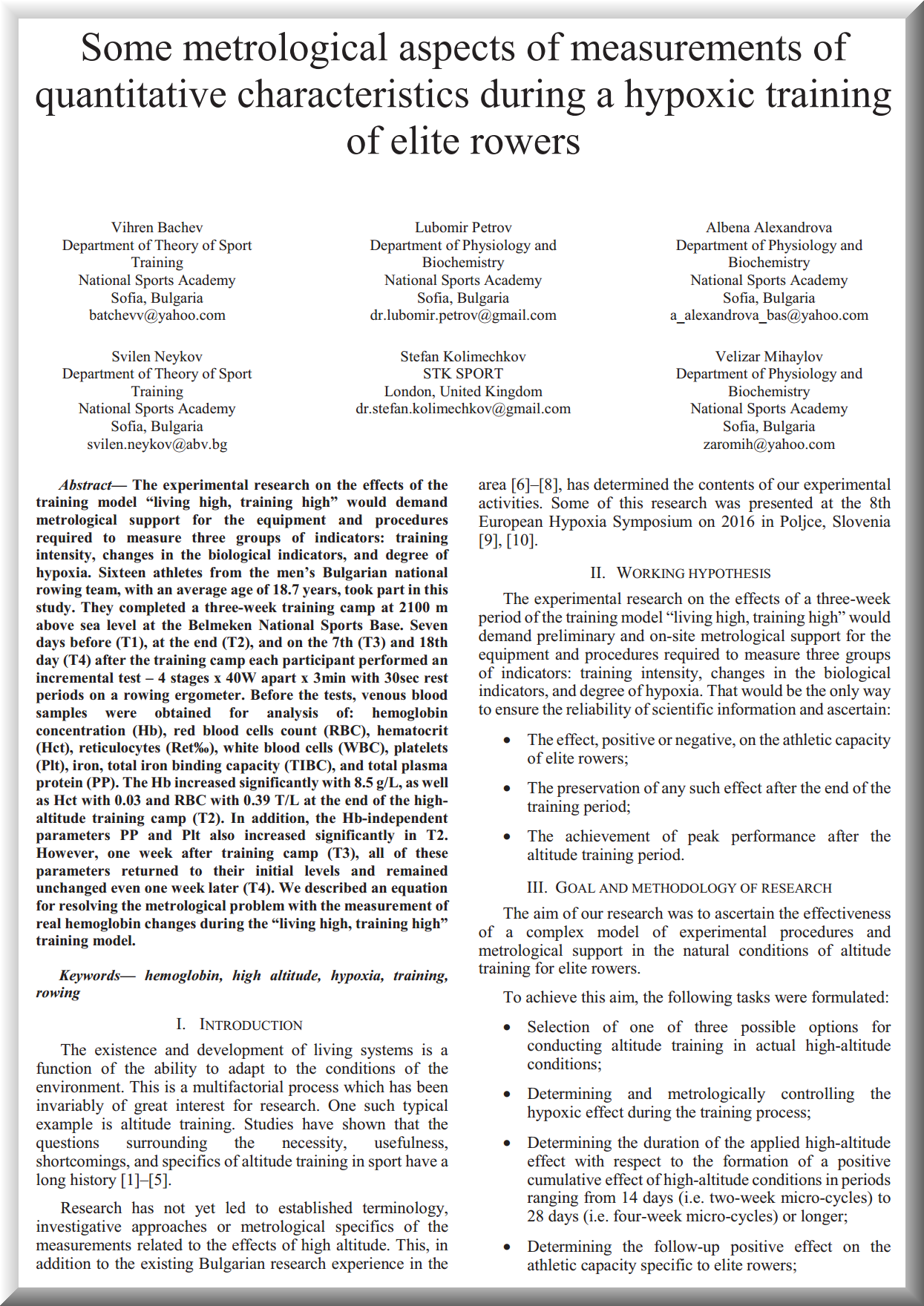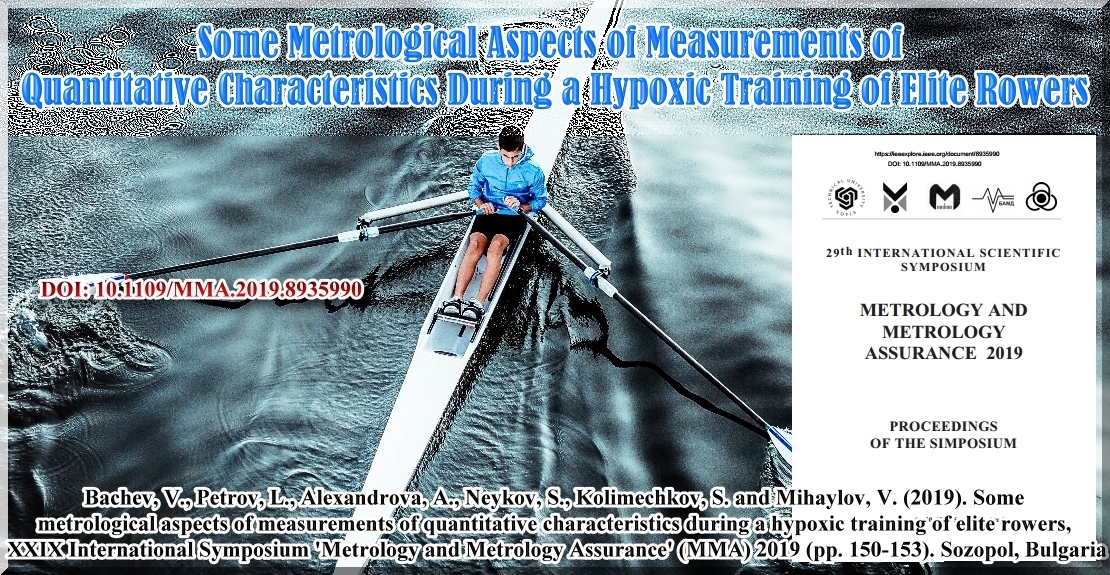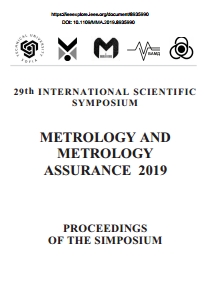Some Metrological Aspects of Measurements of Quantitative Characteristics During a Hypoxic Training of Elite Rowers

Vihren Bachev, Lubomir Petrov, Albena Alexandrova, Svilen Neykov, Stefan Kolimechkov & Velizar Mihaylov
How to cite:
Bachev, V., Petrov, L., Alexandrova, A., Neykov, S., Kolimechkov, S. and Mihaylov, V. (2019). Some metrological aspects of measurements of quantitative characteristics during a hypoxic training of elite rowers, XXIX International Scientific Symposium 'Metrology and Metrology Assurance' (MMA) 2019 (pp. 150-153). Sozopol, Bulgaria. doi: 10.1109/MMA.2019.8935990.

Proceeding Book of the XXIX International Scientific Symposium 'Metrology and Metrology Assurance' 2019

 Bulgaria, Sozopol
Bulgaria, Sozopol
website: www.metrology-bg.org
ABOUT THE PROCEEDING BOOK
This is the Proceeding Book of the 29th International Scientific Symposium 'Metrology and Metrology Assurance' 2019, and it contains full-length articles from the Symposium. This book was published by the IEEE.
ABOUT THIS ARTICLE
This article presents our study on quantitative characteristics during a hypoxic training of professional rowers. The aim of our research was to ascertain the effectiveness of a complex model of experimental procedures and metrological support in the natural conditions of altitude training for elite rowers. Our study was originally presented by Prof. Bachev in the parallel sessions of the 29th International Scientific Symposium 'Metrology and Metrology Assurance' (click here for more information about the presentation) in Sozopol on 8 September 2019. Our article was reviewed by the International Programme Committee and published in the proceeding book of the Symposium, and it is now available for reading on this page.
Some metrological aspects of measurements of quantitative characteristics during a hypoxic training of elite rowers
Published Article in Conference Proceedings

Proceeding Book of the
XXIX International Scientific Symposium 'Metrology and Metrology Assurance' 2019
September 2019, pp. 150-153, ISBN (print): 978-1-7281-2214-4; ISBN (online): 978-1-7281-2213-7; DOI: 10.1109/MMA.2019.8935990
SOME METROLOGICAL ASPECTS OF MEASUREMENTS OF QUANTITATIVE CHARACTERISTICS DURING A HYPOXIC TRAINING OF ELITE ROWERS
Vihren Bachev, Lubomir Petrov, Albena Alexandrova, Svilen Neykov, Stefan Kolimechkov & Velizar Mihaylov
National Sports Academy, Sofia, Bulgaria
STK Sport, London, United Kingdom
ABSTRACT
The experimental research on the effects of the training model “living high, training high” would demand metrological support for the equipment and procedures required to measure three groups of indicators: training intensity, changes in the biological indicators, and degree of hypoxia. Sixteen athletes from the men’s Bulgarian national rowing team, with an average age of 18.7 years, took part in this study. They completed a three-week training camp at 2100 m above sea level at the Belmeken National Sports Base. Seven days before (T1), at the end (T2), and on the 7th (T3) and 18th day (T4) after the training camp each participant performed an incremental test – 4 stages x 40W apart x 3min with 30sec rest periods on a rowing ergometer. Before the tests, venous blood samples were obtained for analysis of: hemoglobin concentration (Hb), red blood cells count (RBC), hematocrit (Hct), reticulocytes (Ret‰), white blood cells (WBC), platelets (Plt), iron, total iron binding capacity (TIBC), and total plasma protein (PP). The Hb increased significantly with 8.5 g/L, as well as Hct with 0.03 and RBC with 0.39 T/L at the end of the highaltitude training camp (T2). In addition, the Hb-independent parameters PP and Plt also increased significantly in T2. However, one week after training camp (T3), all of these parameters returned to their initial levels and remained unchanged even one week later (T4). We described an equation for resolving the metrological problem with the measurement of real hemoglobin changes during the “living high, training high” training model.
Key Words: hemoglobin, high altitude, hypoxia, training, rowing
REFERENCES
[1] C. Lundby and P. Robach, “Does ‘altitude training’ increase exercise performance in elite athletes?,” Experimental Physiology, vol. 101, no. 7, pp. 783–788, Jul. 2016.
[2] J. Stray-Gundersen and B. D. Levine, “Live high, train low at natural altitude,” Scandinavian Journal of Medicine & Science in Sports, vol. 18, pp. 21–28, Jul. 2008.
[3] R. L. Wilber, “Application of altitude/hypoxic training by elite athletes,” J. Hum. Sport Exerc, vol. 6, no. 2, pp. 271–286, Sep. 2011.
[4] J. W. Duke, R. F. Chapman, B. D. Levine, K. Lancaster, and N. Smart, “Live-High Train-Low Altitude Training on Maximal Oxygen Consumption in Athletes: A Systematic Review and Meta-Analysis,” International Journal of Sports Science & Coaching, vol. 7, no. 1, pp. 1–13, Mar. 2012.
[5] J. J. Saugy et al., “Same performance changes after live high-train low in normobaric vs. hypobaric hypoxia,” Frontiers in Physiology, 2016.
[6] D. Dasheva and S. Neikov, “Study of the effect of high-altitude training during the preparatory period in elite female rowers,” Sports & Science, no. 3, pp. 3–17, 2003.
[7] A. Alexandrova, “Changes in cells oxidative status during high-altitude hypoxia.,” Sport & Science, no. 4, pp. 59–76, 2016.
[8] K. Krastev and I. Iliev, High-altitude, hypoxia and sport. Sofia: Medicine and Sport, 1970.
[9] L. Mladenov, L. Petrov, V. Bachev, S. Neykov, P. Zografov, and P. Somlev, “The effects of classic live high train high altitude training on hemoglobin and red blood cells in rowers – preliminary study.,” in 8th European Hypoxia Symposium “High altitude and isobaric hypoxia influence on human performance” science and practice;9.-11.9.2016 Poljce,Slovenia, 2016, p. 38.
[10] L. Petrov, S. Neykov, S. Andonov, A. Alexandrova, V. Mihaylov, and V. Bachev, “Dynamics of individual changes in functional capacity and blood parameters (urea and uric acid) during real and simulated altitude training of high performance rowers,” in 8th European Hypoxia Symposium “High altitude and isobaric hypoxia influence on human performance” science and practice; 9-11.9.2016 Poljce, Slovenia, 2016, p. 39.
[11] A. Klusiewicz and J. Faff, “Indirect methods of estimating maximal oxygen uptake on the rowing ergometer,” Biology of sport., vol. 20, no. 3, p. 181, 2003.
[12] A. Klusiewicz, L. Borkowski, D. Sitkowski, K. Burkhard-Jagodzińska, B. Szczepańska, and M. Ładyga, “Indirect Methods of Assessing Maximal Oxygen Uptake in Rowers: Practical Implications for Evaluating Physical Fitness in a Training Cycle,” Journal of Human Kinetics, vol. 50, no. 50, pp. 187–194, 2016.
[13] G. P. Millet, B. Roels, L. Schmitt, X. Woorons, and J. P. Richalet, “Combining Hypoxic Methods for Peak Performance,” Sports Medicine, vol. 40, no. 1, pp. 1–25, Jan. 2010.
[14] L. G. Myhre, D. B. Dill, F. C. Hall, and D. K. Brown, “Blood Volume Changes during Three-Week Residence at High Altitude,” 1970.
[15] G. R. Zubieta-Calleja, P.-E. Paulev, L. Zubieta-Calleja, and G. Zubieta-Castillo, “Altitude adaptation through hematocrit changes.,” Journal of physiology and pharmacology : an official journal of the Polish Physiological Society, vol. 58 Suppl 5, no. Pt 2, pp. 811–8, Nov. 2007.
[16] D. B. Dill, S. M. Horvath, T. E. Dahms, R. E. Parker, and J. R. Lynch, “Hemoconcentration at altitude.,” Journal of Applied Physiology, vol. 27, no. 4, pp. 514–518, Oct. 1969.
[17] F. A. Basset et al., “Effects of short-term normobaric hypoxia on haematology, muscle phenotypes and physical performance in highly trained athletes,” Experimental Physiology, vol. 91, no. 2, pp. 391–402, Mar. 2006.
[18] W. Schmidt and N. Prommer, “The optimised CO-rebreathing method: a new tool to determine total haemoglobin mass routinely,” European Journal of Applied Physiology, vol. 95, no. 5–6, pp. 486–495, Dec. 2005.
[19] R. Falz and M. Busse, “Determination of hemoglobin mass in humans by measurement of CO uptake during inhalation of a CO-air mixture: a proof of concept study,” Physiological Reports, vol. 6, no. 17, p. e13849, Sep. 2018.
[20] P. Atkins and R. E. Lempke, “The effect of hypoxia on the platelet count,” British Journal of Surgery, vol. 57, no. 8, pp. 583–586, Aug. 1970.
[21] G. Banfi, M. Marinelli, G. S. Roi, and M. Giacometti, “Platelet indices in athletes performing a race in altitude environment.,” Journal of clinical laboratory analysis, vol. 9, no. 1, pp. 34–6, 1995.
[22] J. Novosadová, “The changes in hematocrit, hemoglobin, plasma volume and proteins during and after different types of exercise.,” European journal of applied physiology and occupational physiology, vol. 36, no. 3, pp. 223–30, Mar. 1977.
[23] D. B. Dill and D. L. Costill, “Calculation of percentage changes in volumes of blood, plasma, and red cells in dehydration.,” Journal of applied physiology, 1974.
Full Text: Some metrological aspects of measurements of quantitative characteristics during a hypoxic training of elite rowers. Proceeding Book of the MMA Symposium 2019
This article is published in a proceeding book without open access!
Available on the official website of the Publisher
The abstract is also available on ResearchGate
Authors
Professor Vihren Bachev DSc
Department of Theory and Methods of Sports Training, National Sports Academy, Sofia, Bulgaria
Associate Professor Dr Lubomir Petrov PhD
Department of Physiology and Biochemistry, National Sports Academy, Sofia, Bulgaria
Academia.edu | ORCID | Research Gate | Google Scholar
Associate Professor Albena Alexandrova PhD
Department of Physiology and Biochemistry, National Sports Academy, Sofia, Bulgaria
Academia.edu | ORCID | Research Gate | Google Scholar
Professor Svilen Neykov PhD
Department of Theory and Methods of Sports Training, National Sports Academy, Sofia, Bulgaria
Stefan Kolimechkov PhD
Department of Physiology and Biochemistry, National Sports Academy, Sofia, Bulgaria
Academia.edu | ORCID | Research Gate | Google Scholar
Corresponding author: dr.stefan.kolimechkov@gmail.com
Associate Professor Velizar Mihaylov PhD
Department of Physiology and Biochemistry, National Sports Academy, Sofia, Bulgaria
How to cite this article:
Bachev, V., Petrov, L., Alexandrova, A., Neykov, S., Kolimechkov, S. and Mihaylov, V. (2019). Some metrological aspects of measurements of quantitative characteristics during a hypoxic training of elite rowers, XXIX International Scientific Symposium 'Metrology and Metrology Assurance' (MMA) 2019 (pp. 150-153). Sozopol, Bulgaria. doi: 10.1109/MMA.2019.8935990.

